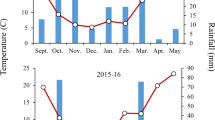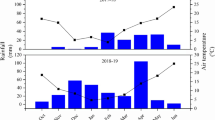Abstract
A factorial split-plot experiment (2015–17) was carried out in a randomized complete block design with three replications at Karaj, Iran, to investigate the quantitative and qualitative responses of rapeseed genotypes to the exogenous application of salicylic acid at various plant densities. Three plant densities (40, 50, and 60 plants m−2) and two levels of application of salicylic acid (non-application and foliar application) were factorial in the main plots and six rapeseed genotypes (HW118, WPN6, HL3721, L14, Tassilo, and Natali) were in sub-plots. The number of siliques per plant, number of seeds per silique, seed yield, and oil yield improved when rapeseed genotypes treated with salicylic acid. The oil quality of studied genotypes enhanced due to a reduction in erucic acid and glucosinolate contents under the foliar application of salicylic acid. On average, by foliar application of salicylic acid, the highest seed and oil yields at the density of 40 plants m−2 belonged to the L14 genotype, while the HW118 produced the maximum seed and oil yields at the densities of 50 and 60 plants m−2. Generally, rapeseed genotypes should be cultivated at the density of 40 plant m−2 and treated with foliar application of salicylic acid for achieving the maximum seed yield and oil quality.
Zusammenfassung
Ein faktorieller Split-Plot-Versuch (2015–17) wurde in einem randomisierten vollständigen Blockdesign mit drei Wiederholungen in Karaj, Iran, durchgeführt, um die quantitativen und qualitativen Reaktionen von Rapsgenotypen auf die exogene Anwendung von Salicylsäure bei verschiedenen Pflanzdichten zu untersuchen. Drei Pflanzdichten (40, 50 und 60 Pflanzen pro m2) und zwei Arten der Salicylsäureapplikation (keine Applikation und Blattapplikation) waren Faktoren in den Hauptplots, sechs Rapsgenotypen (HW118, WPN6, HL3721, L14, Tassilo und Natali) in den Subplots. Die Anzahl der Schoten pro Pflanze, die Anzahl der Samen pro Schote, der Samenertrag und der Ölertrag verbesserten sich, wenn die Rapsgenotypen mit Salicylsäure behandelt wurden. Die Ölqualität der untersuchten Genotypen verbesserte sich aufgrund einer Reduzierung des Erucasäure- und Glucosinolatgehalts unter der Blattapplikation von Salicylsäure. Im Durchschnitt erreichte bei einer Blattapplikation von Salicylsäure der Genotyp L14 bei einer Dichte von 40 Pflanzen pro m2 die höchsten Samen- und Ölerträge, während HW118 bei Dichten von 50 und 60 Pflanzen pro m2 die höchsten Samen- und Ölerträge lieferte. Generell sollten die Rapsgenotypen bei einer Dichte von 40 Pflanzen pro m2 angebaut und mit Salicylsäure behandelt werden, um den maximalen Samenertrag und die beste Ölqualität zu erreichen.

Similar content being viewed by others
References
Amiri-Darban N, Nourmohammadi GH, Shirani Rad AH, Mirhadi SMJ, Majidi Heravan I (2020) Potassium sulfate and ammonium sulfate affect quality and quantity of camelina oil grown with different irrigation regimes. Ind Crops Prod 148:112308
Ashkiani A, Sayfzadeh S, Shirani Rad AH, Valadabadi A, Hadidi Masouleh E (2020) Effects of foliar zinc application on yield and oil quality of rapeseed genotypes under drought stress. J Plant Nutr. https://doi.org/10.1080/01904167.2020.1739299
Askari E, Ehsanzadeh P (2015a) Drought stress mitigation by foliar application of salicylic acid and their interactive effects on physiological characteristics of fennel (Foeniculum vulgare Mill.) genotypes. Acta Physiol Plant 37:4–14
Askari E, Ehsanzadeh P (2015b) Effectiveness of exogenous salicylic acid on root and shoot growth attributes, productivity, and water use efficiency of water-deprived fennel genotypes. Hortic Environ Biotechnol 56:689–696. https://doi.org/10.1007/s13580-015-0038-9
Azadmard-Damirchi S, Dutta PC (2006) Novel solid-phase extraction method to separate 4 desmethyl-, 4‑monomethyl-, and 4, 40-dimethylsterols in vegetable oils. J Chromatogr 1108:183–187
Azadmard-Damirchi S, Savage GP, Dutta PC (2005) Sterol fractions in hazelnut and virgin olive oils and 4, 40-dimethylsterols as possible markers for detection of adulteration of virgin olive oil. J Am Oil Chem Soc 82:717–725
Bybordi A (2016) Influence of zeolite, selenium and silicon upon some agronomic and physiologic characteristics of canola grown under salinity. Comm Soil Sci Plant Anal 47:832–850
Caliskan ME, Kusman N, Caliskan S (2009) Effects of plant density on the yield and yield components of true potato seed (TPS) hybrids in early and main crop potato production systems. Field Crop Res 114:223–232
Confortin TC, Todero I, Luft L, Ugalde A, Mazutti MA et al (2019) Oil yields, protein contents, and cost of manufacturing of oil obtained from different hybrids and sowing dates of canola. J Environ Chem Eng 7(2):102972
Diepenbrock W (2000) Yield analysis of winter oilseed rape: a review. Field Crop Res 67:35–49
Elhamahmy MAM, Mahmoud MF, Bayoumi TY (2016) The effect of applying exogenous salicylic acid on aphid infection and its influence on histo-physiological traits and thermal imaging of canola. Cercet Agron Mold 166(2):67–85
Estaji A, Niknam F (2020) Foliar salicylic acid spraying effect’ on growth, seed oil content, and physiology of drought-stressed Silybum marianum L. plant. Agric Water Manag 234:106116
Eyni-Nargeseh H, Aghaalikhani M, Shirani Rad AH, Mokhtassi-Bidgoli A, Modares Sanavy SAM (2020a) Comparison of 17 rapeseed cultivars under terminal water deficit conditions using drought tolerance indices. J Agr Sci Tech 22(2):489–503
Eyni-Nargeseh H, Aghaalikhani M, Shirani Rad AH, Mokhtassi-Bidgoli A, Modares Sanavy SAM (2020b) Late season deficit irrigation for water-saving: Selection of rapeseed (Brassica napus) genotypes based on quantitative and qualitative features. Arch Agron Soil Sci 66(1):126–137
Faraji A (2014) Seed weight in canola as a function of assimilate supply and source-sink ratio during seed filling period. Int J Plant Prod 8:255–270
Fariduddin Q, Hayat S, Ahmad A (2003) Salicylic acid influences net photosynthetic rate, carboxylation efficiency, nitrate reductase activity, and seed yield in Brassica juncea. Photosynt 41:281–284
Fathi-Achachlouei F, Azadmard-Damirchi S (2009) Milk thistle seed oil constituents from different varieties grown in Iran. J Am Oil Chem Soc 86:643–649
Guo-zheng Y, Xue-jiao L, Yi-chum N, Xian-long Zh (2014) Effects of plant density on yield and canopy micro environment in hybrid cotton. J Integr Agric 13(10):2154–2163
Harinder P, Makkar S, Siddhuraju P, Becker K (2007) Plant secondary metabolites. Hummana Press, , pp 58–60
Hayat Q, Hayat S, Ifran M, Ahmad A (2010) Effect of exogenous salicylic acid under changing environment: a review. Environ Exp Bot 68:14–25
Ijaz M, Sher A, Sattar A, Shahid M, Nawaz A et al (2019) Response of canola (Brassica napus L.) to exogenous application of nitrogen, salicylic acid and gibberellic acid under an arid climate. Soil Environ 38(1):90–96
International standard ISO (1992) Oilseeds-determination of oil content-Method using continuous-wave low-resolution nuclear magnetic resonance spectrometry (Rapid method).
Janda T, Gondor OK, Yordanova R, Szalai G, Pal M (2014) Salicylic acid and photosynthesis: signalling and effects. Acta Physiol Plant 36:2537–2546. https://doi.org/10.1007/s11738-014-1620-y
Jini D, Joseph B (2017) Physiological mechanism of salicylic acid for alleviation of salt stress in rice. Rice Sci 24(2):97–108
Khan Sh, Anwar S, Kuai J, Noman A, Shahid M et al (2018) Alteration in yield and oil quality traits of winter rapeseed by lodging at different planting density and nitrogen rates. Sci Rep 8:634
Kuai J, Sun Y, Zuo Q, Huang H, Liao Q et al (2015) The yield of mechanically harvested rapeseed (Brassica napus L.) can be increased by optimum plant density and row spacing. Sci Rep 5:18835
Li YSH, Yu CHB, Zhu Sh, Xif LH, Hu XJ et al (2014) High planting density benefits to mechanized harvest and nitrogen application rates of oilseed rape (Brassica napus L.). Soil Sci Plant Nutr 60:384–392
Metwally AM, Radi AA, El-Shazoly R, Hamada AM (2018) The role of calcium, silicon and salicylic acid treatment in protection of canola plants against boron toxicity stress. J Plant Res 131(6):1015–1028
Momoh EJJ, Zhou W (2001) Growth and yield responses to plant density and stage of transplanting in winter oilseed rape (Brassica napus L.). J Agron Crop Sci 186:253–259
Moradi Aghdam A, Sayfzadeh S, Shirani Rad AH, Valadabadi SA, Zakerin HR (2019) The assessment of water stress and delay cropping on quantitative and qualitative traits of rapeseed genotypes. Ind Crop Prod 131:160–165
Nasiri A, Samdaliri M, Shirani Rad A, Shahsavari N, Mirkale AM, Jabbari H (2017) Effect of plant density on yield and physiological characteristics of six canola cultivars. J Sci Agric 1:249–253
Ozer H (2003) The effect of plant population densities on growth, yield and yield components of two spring rapeseed cultivars. Plant Soil Environ 49(9):422–426
Rahimi-Moghaddam S, Eyni-Nargeseh H, Kalantar Ahmadi SA, Azizi KH (2020) Towards withholding irrigation regimes and resistant genotypes as strategies to increase canola production in drought-prone environments: A modeling approach. Agric Water Manag 243:106487. https://doi.org/10.1016/j.agwat.2020.106487
Razmi N, Ebadi A, Daneshian J, Jahanbakhsh S (2017) Salicylic acid induced changes on antioxidant capacity, pigments and grain yield of soybean genotypes in water deficit condition. J Plant Interac 12(1):457–464
Ruuska SA, Schwender J, Ohlrogge JB (2004) Te capacity of green oilseeds to utilize photosynthesis to drive biosynthetic processes. Plant Physiol 136:2700–2709
Savage GP, Mcneil DL, Dutta PC (1997) Lipid composition and oxidative stability of oils in hazelnuts (Corylus avellana L.) grown in New Zealand. J Am Oil Chem Soc 74:755–759
Shirani Rad AH, Kavandi H, Bitarafan Z (2011) Plant density and foliar application of zn and fe effects on some quantitative and qualitative traits of german chamomile. Int J Sci Adv Tech 1(10):59–64
Starner DE, Hamama AA, Bhardwaj L (1999) Canola oil yield and quality as affected by production practices in Virginia. In: Janick J (ed) Perspectives on new crops and new uses. ASHS Press, Alexandria, pp 254–256
Ullah F, Bano A, Nosheen A (2012) Effects of plant growth regulators on growth and oil quality of canola (Brassica napus L.) under drought stress. Pak J Bot 44(6):1873–1880
Yousefzadeh Najafabadi M, Ehsanzadeh P (2017a) Photosynthetic and antioxidative upregulation in drought-stressed sesame (Sesamum indicum L.) subjected to foliar-applied salicylic acid. Photosynt 55:611–622. https://doi.org/10.1007/s11099-017-0673-8
Yousefzadeh Najafabadi M, Ehsanzadeh P (2017b) Salicylic acid effects on osmoregulation and seed yield in drought-stresses sesame. Agron J 9(4):1404–1422
Zhang Sh, Liao X, Zhang Ch, Xu H (2012) Influences of plant density on the seed yield and oil content of winter oilseed rape (Brassica napus L.). Ind Crops Prod 40:27–32
Acknowledgements
This study is a part of a Ph.D. dissertation. The authors gratefully acknowledge the support provided for this survey by the Islamic Azad University, Tehran, Iran, and Seed and Plant Improvement Institute (SPII), Karaj, Iran.
Author information
Authors and Affiliations
Corresponding author
Ethics declarations
Conflict of interest
F. Ganj-Abadi, A.H. Shirani Rad, B. Sani and H. Mozafari declare that they have no competing interests.
Rights and permissions
About this article
Cite this article
Ganj-Abadi, F., Shirani Rad, A.H., Sani, B. et al. Grain Yield and Qualitative of Rapeseed Genotypes Change in Response to Exogenous Application of Salicylic Acid and Planting Density. Gesunde Pflanzen 73, 335–344 (2021). https://doi.org/10.1007/s10343-021-00558-2
Received:
Accepted:
Published:
Issue Date:
DOI: https://doi.org/10.1007/s10343-021-00558-2




